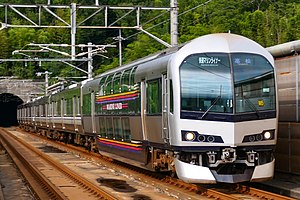This article needs additional citations for verification. (February 2023) |
The Honshi-Bisan Line (本四備讃線, Honshi-Bisan-sen) is a Japanese railway line which connects Kurashiki in Okayama Prefecture with Utazu in Kagawa Prefecture. It is owned and operated jointly by West Japan Railway Company (JR West) and Shikoku Railway Company (JR Shikoku). The line is the central section of the Seto-Ōhashi Line, a service connecting Okayama and Takamatsu; as a result, the Honshi-Bisan Line is rarely referred to by itself, but rather as a part of the larger Seto-Ōhashi Line service.
| Honshi-Bisan Line | |||
|---|---|---|---|
 | |||
 Marine Liner on the Honshi-Bisan Line | |||
| Overview | |||
| Owner | JR West, JR Shikoku | ||
| Locale | Okayama, Kagawa prefectures | ||
| Termini | |||
| Stations | 6 | ||
| Service | |||
| Type | Heavy rail | ||
| Operator(s) | JR West, JR Shikoku, JR Freight | ||
| History | |||
| Opened | 1988 | ||
| Technical | |||
| Line length | 31.0 km (19.3 mi) | ||
| Track gauge | 1,067 mm (3 ft 6 in) | ||
| Electrification | 1,500 V DC overhead | ||
| Operating speed | 130 km/h (81 mph) | ||
| |||
The line's name comes from the two islands it links: Honshu and Shikoku, and the old provincial names of the areas through which the line passes, Bitchū Province/Bizen Province and Sanuki Province.
History
editThe 13 km (8.1 mi) Chayamachi - Kojima section opened on 20 March 1988,[1] and the 18 km (11 mi) Kojima - Utazu on 10 April 1988 in conjunction with the opening of the Seto-Ohashi Bridge system.
This provided the first rail connection between Honshu and Shikoku, prior to this passengers traveled via the Uno Line and train ferry to Takamatsu.
The opening of the line also facilitated electrification of the Yosan Line between Takamatsu and Matsuyama, enabling direct services from both cities to Okayama.
Basic data
edit- Operators, distances:
- West Japan Railway Company (JR West) (Services and tracks)
- Chayamachi – Kojima: 12.9 km (8.0 mi)
- Shikoku Railway Company (JR Shikoku) (Services and tracks)
- Kojima – Utazu: 18.1 km (11.2 mi)
- Japan Freight Railway Company (JR Freight) (Services)
- Chayamachi – Kojima – Utazu: 31.0 km (19.3 mi)
- West Japan Railway Company (JR West) (Services and tracks)
- Gauge: 3 ft 6 in (1,067 mm) narrow gauge
- Stations: 6
- Double-tracked section: Entire line
- Electrification: 1500 V DC
- Railway signalling: Centralized Traffic Control (CTC)
- Maximum speed:
- Chayamachi – Kojima: 130 km/h (80 mph)
- Kojima – Utazu: 120 km/h (75 mph)
- CTC center:
- Chayamachi – Kojima: Okayama Transport Control Center
- Kojima – Utazu: Takamatsu Control Center
Station list
edit| No. | Station | Japanese | Distance (km) |
Transfers | Location | |
|---|---|---|---|---|---|---|
| M08 | Chayamachi | 茶屋町 | 0.0 | Uno Line | Kurashiki | Okayama |
| M09 | Uematsu | 植松 | 2.9 | Okayama | ||
| M10 | Kimi | 木見 | 5.6 | Kurashiki | ||
| M11 | Kaminochō | 上の町 | 9.7 | |||
| M12 | Kojima | 児島 | 12.9 | |||
| Border between JR West and JR Shikoku | ||||||
| Y09 | Utazu | 宇多津 | 31.0 | ■ Yosan Line | Utazu, Ayauta District | Kagawa |
See also
editReferences
edit- ^ "データで見るJR西日本 2022" [JR West Japan 2022 in Data] (PDF). westjr.co.jp (in Japanese). 2022. pp. 88–90. Archived from the original (PDF) on 14 December 2022. Retrieved 7 February 2023.
External links
edit- JR Shikoku official website (in Japanese)
- JR West official website (in Japanese)
